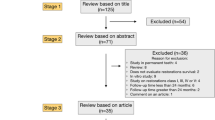Abstract
Objectives The objective of this systematic review was to evaluate the success of endocrown restorations on molars in comparison with endocrown restorations on premolars.
Registration number The methodology for this review is registered with the PROSPERO database (CRD42019149543).
Data sources Medline, Embase, Dentistry & Oral Sciences Source and Cochrane CENTRAL were searched through January 2020, supplemented with hand searching of additional relevant journals.
Data selection and data extraction Two independent reviewers screened studies against predefined inclusion criteria and extracted data.
Data analysis Narrative analysis was carried out and random-effects meta-analysis was performed where possible.
Results Out of the selected eight studies, reported success rate of endocrown restoration in molars varied from 72.73% to 99.57% and in premolars ranged from 68.75% to 100%, with a follow-up range of 3-19 years. The pooled odds ratio and 95% confidence intervals for failure rates in molars compared to premolars in four studies selected for meta-analysis were 1.096 (95% CI: 0.280, 4.292).
Conclusions These findings showed similar success rates and no difference in the rate of endocrown failures between molars and premolars, thus suggesting that premolars may be considered suitable candidates for endocrowns. However, the findings should be interpreted with caution due to methodological limitations of the included studies. Further better quality and specifically designed controlled trials directly comparing the clinical performance of endocrowns on molars and premolars are required.
Key points
-
The available evidence suggests that endocrowns are a reliable alternative to post-retained restorations in molars; however, the evidence for premolars remains unclear.
-
This systematic review aimed to evaluate the evidence regarding longevity of endocrowns on both premolars and molars.
-
The results of this review indicate that there is no difference in the rate of failures between endocrowns on molars and premolars, and that premolars may potentially be considered candidates for endocrowns.
This is a preview of subscription content, access via your institution
Access options
Subscribe to this journal
Receive 24 print issues and online access
$259.00 per year
only $10.79 per issue
Buy this article
- Purchase on Springer Link
- Instant access to full article PDF
Prices may be subject to local taxes which are calculated during checkout





Similar content being viewed by others
References
Mannocci F, Bertelli E, Sherriff M, Watson T F, Ford T P. Three-year clinical comparison of survival of endodontically treated teeth restored with either full cast coverage or with direct composite restoration. J Prosthet Dent 2002; 88: 297-301.
El Elagra M. Endocrown preparation: Review. Int J Appl Dent Sci 2019; 5: 253-256.
Belli S, Erdemir A, Yildirim C. Reinforcement effect of polyethylene fibre in root-filled teeth: Comparison of two restoration techniques. Int Endod J 2006; 39: 136-142.
Mireku A S, Romberg E, Fouad A F, Arola D. Vertical fracture of root filled teeth restored with posts: The effects of patient age and dentine thickness. Int Endod J 2010; 43: 218-225.
Randow K, Glantz P. On cantilever loading of vital and non-vital teeth an experimental clinical study. Acta Odontol Scand 1986; 44: 271-277.
Yassen G H, Vail M M, Chu T G, Platt J A. The effect of medicaments used in endodontic regeneration on root fracture and microhardness of radicular dentine. Int Endod J 2013; 46: 688-695.
Schwartz R S, Robbins J W. Post placement and restoration of endodontically treated teeth: A literature review. J Endod 2004; 30: 289-301.
Jiang W, Bo H, Yongchun G, LongXing N. Stress distribution in molars restored with inlays or onlays with or without endodontic treatment: A three-dimensional finite element analysis. J Prosthet Dent 2010; 103: 6-12.
Ng Y L, Mann V, Gulabivala K. A prospective study of the factors affecting outcomes of non-surgical root canal treatment: part 2: tooth survival. Int Endod J 2011; 44: 610-625.
Olcay K, Ataoglu H, Belli S. Evaluation of Related Factors in the Failure of Endodontically Treated Teeth: A Cross-sectional Study. J Endod 2018; 44: 38-45.
Bindl A, Mormann W H. Clinical evaluation of adhesively placed Cerec endo-crowns after 2 years - preliminary results. J Adhes Dent 1999; 1: 255-266.
Gulabivala K, Ng Y. Value of root-filled teeth in maintaining a functional dentition for life. Br Dent J 2019; 226: 769.
Fages M, Bennasar B. The endocrown: A different type of all-ceramic reconstruction for molars. J Can Dent Assoc 2013; 79: d140.
Sevimli G, Cengiz S, Oruc M S. Endocrowns: review. J Istanb Univ Fac Dent 2015; 49: 57-63.
Chang C, Kuo J, Lin Y, Chang Y. Fracture resistance and failure modes of CEREC endo-crowns and conventional post and core-supported CEREC crowns. J Dent Sci 2009; 4: 110-117.
Abu-Awwad M. A modern guide in the management of endodontically treated posterior teeth. European J Gen Dent 2019; 8: 63.
Sedrez-Porto J, de Oliveira da Rosa W L, da Silva A F, Münchow E A, Pereira-Cenci T. Endocrown restorations: A systematic review and meta-analysis. J Dent 2016; 52: 8-14.
Govare N, Contrepois M. Endocrowns: A systematic review. J Prosthet Dent 2020; DOI: 10.1016/j.prosdent.2019.04.009.
Bindl A, Richter B, Mörmann W H. Survival of ceramic computer-aided design/manufacturing crowns bonded to preparations with reduced macroretention geometry. Int J Prosthodont 2005; 18: 219-224.
Moher D, Liberati A, Tetzlaff J, Altman D G. Preferred reporting items for systematic reviews and meta-analyses: The PRISMA statement. Ann Intern Med 2009; 151: 264-269.
Bolla M, Muller-Bolla M, Borg C, Lupi-Pegurier L, Laplanche O, Leforestier E. Root canal posts for the restoration of root filled teeth. Cochrane Database Syst Rev 2007; DOI: 10.1002/14651858.CD004623.pub2.
Reichardt C. Refworks. Public Serv Q 2010; 6: 366-367.
Otto T, Mörmann W H. Clinical performance of chairside CAD/CAM feldspathic ceramic posterior shoulder crowns and endocrowns up to 12 years. Int J Comput Dent 2015; 18: 147-161.
Fages M, Raynal J, Tramini P, Cuisinier F J, Durand J. Chairside computer-aided design/computer-aided manufacture all-ceramic crown and endocrown restorations: A 7year survival rate study. Int J Prosthodont 2017; 30: 556-560.
Borgia Botto E, Barón R, Borgia J L. Endocrown: A retrospective patient series study, in a 8 to 19-year period. Odontoestomatología 2016; 18: 48-59.
Thomas B H, Ciliska D, Dobbins M, Micucci S. A process for systematically reviewing the literature: Providing the research evidence for public health nursing interventions. Worldviews Evid Based Nurs 2004; 1: 176-184.
Liu X H, Ma L. Use of casting inlays with pulp chamber retention to restore extensive damaged crowns of molars. Shanghai J Stomatol 2008; 17: 30-32.
Roggendorf M J, Kramer N, Dippold C et al. Effect of proximal box elevation with resin composite on marginal quality of resin composite inlays in vitro. J Dent 2012; 40: 1068-1073.
Ozyoney G, Yan Koğlu F, Tağtekin D, Hayran O. The efficacy of glass-ceramic onlays in the restoration of morphologically compromised and endodontically treated molars. Int J Prosthodont 2013; 26: 230-234.
Belleflamme M M, Geerts S O, Louwette M M, Grenade C F, Vanheusden A J, Mainjot A K. No post-no core approach to restore severely damaged posterior teeth: An up to 10-year retrospective study of documented endocrown cases. J Dent 2017; 63: 1-7.
Dawood A, Patel S. The dental practicality index-assessing the restorability of teeth. Br Dent J 2017; 222: 755.
Breeding L C, Dixon D L, Caughman W F. The curing potential of light-activated composite resin luting agents. J Prosthet Dent 1991; 65: 512-518.
D'Arcangelo C, Vanini L, Casinelli M et al. Adhesive cementation of indirect composite inlays and onlays: A literature review. Compend Contin Educ Dent 2015; 36: 570-577.
Kilinc E, Antonson S A, Hardigan P C, Kesercioglu A. The effect of ceramic restoration shade and thickness on the polymerization of light-and dual-cure resin cements. Oper Dent 2011; 36: 661-669.
Ozyesil A G, Usumez A, Gunduz B. The efficiency of different light sources to polymerize composite beneath a simulated ceramic restoration. J Prosthet Dent 2004; 91: 151-157.
Gregor L, Bouillaguet S, Onisor I, Ardu S, Krejci I, Rocca G T. Microhardness of light-and dual-polymerizable luting resins polymerized through 7.5mmthick endocrowns. J Prosthet Dent 2014; 112: 942-948.
Imen D. "ENDOCROWN": A reliable alternative to restorate RCT molar! - two case reports. Adv Dent Oral Health 2018; DOI: 10.19080/ADOH.2018.09.555774.
Schwartz R S, Robbins J W. Post placement and restoration of endodontically treated teeth: A literature review. J Endod 2004; 30: 289-301.
Schwartz R S, Fransman R. Adhesive dentistry and endodontics. part 2: Bonding in the root canal system - the promise and the problems: A review. J Endod 2006; 32: 1125-1134.
Sedrez-Porto J, Münchow E A, Valente L L, Cenci M S, Pereira-Cenci T. New material perspective for endocrown restorations: Effects on mechanical performance and fracture behaviour. Braz Oral Res 2019; DOI: 10.1590/1807-3107bor-2019.vol33.0012.
Ramírez-Sebastià A, Bortolotto T, Roig M, Krejci I. Composite vs ceramic computer-aided design/computer-assisted manufacturing crowns in endodontically treated teeth: Analysis of marginal adaptation. Oper Dent 2013; 38: 663-673.
Dietschi D, Duc O, Krejci I, Sadan A. Biomechanical considerations for the restoration of endodontically treated teeth: A systematic review of the literature, part II (evaluation of fatigue behaviour, interfaces, and in vivo studies). Quintessence Int 2008; 39: 117-129.
Beier U S, Kapferer I, Dumfahrt H. Clinical long-term evaluation and failure characteristics of 1,335 all-ceramic restorations. Int J Prosthodont 2012; 25: 70-78.
Otto T. Computer-aided direct all-ceramic crowns: preliminary 1year results of a prospective clinical study. Int J Periodontics Restorative Dent 2004; 24: 446-455.
Bernhart J, Bräuning A, Altenburger M J, Wrbas K T. Cerec3D endocrownstwoyear clinical examination of CAD/CAM crowns for restoring endodontically treated molars. Int J Comput Dent 2010; 13: 141-154.
Decerle N, Bessadet M, Munoz-Sanchez M L, Eschevins C, Veyrune J, Nicolas E. Evaluation of cerec endocrowns: A preliminary cohort study. Eur J Prosthodont Restor Dent 2014; 22: 89-95.
Tifooni A, Al-Nuaimi N, Dawood A, Mannocci F, Patel S. Validation of the effectiveness of the dental practicality index in predicting the outcome of root canal retreatments. Int Endod J 2019; 52: 1403-1409.
Acknowledgements
The authors would like to acknowledge Dr Soh Hui Yuh, Lecturer, Faculty of Dentistry, National University of Malaysia, for the translation of a study from Mandarin to be used in this systematic review.
Author information
Authors and Affiliations
Corresponding author
Ethics declarations
This research did not receive any specific grant from funding agencies in the public, commercial or not-for-profit sectors. The authors do not have any conflict of interest to declare related to this study.
Electronic supplementary material
Rights and permissions
About this article
Cite this article
Thomas, R., Kelly, A., Tagiyeva, N. et al. Comparing endocrown restorations on permanent molars and premolars: a systematic review and meta-analysis. Br Dent J (2020). https://doi.org/10.1038/s41415-020-2279-y
Received:
Accepted:
Published:
DOI: https://doi.org/10.1038/s41415-020-2279-y
This article is cited by
-
Evidence-based fact checking for selective procedures in restorative dentistry
Clinical Oral Investigations (2023)
-
Impact of different axial wall designs on the fracture strength and stress distribution of ceramic restorations in mandibular first molar
BMC Oral Health (2022)
-
Comparison of retention and fracture load of endocrowns made from zirconia and zirconium lithium silicate after aging: an in vitro study
BMC Oral Health (2022)



